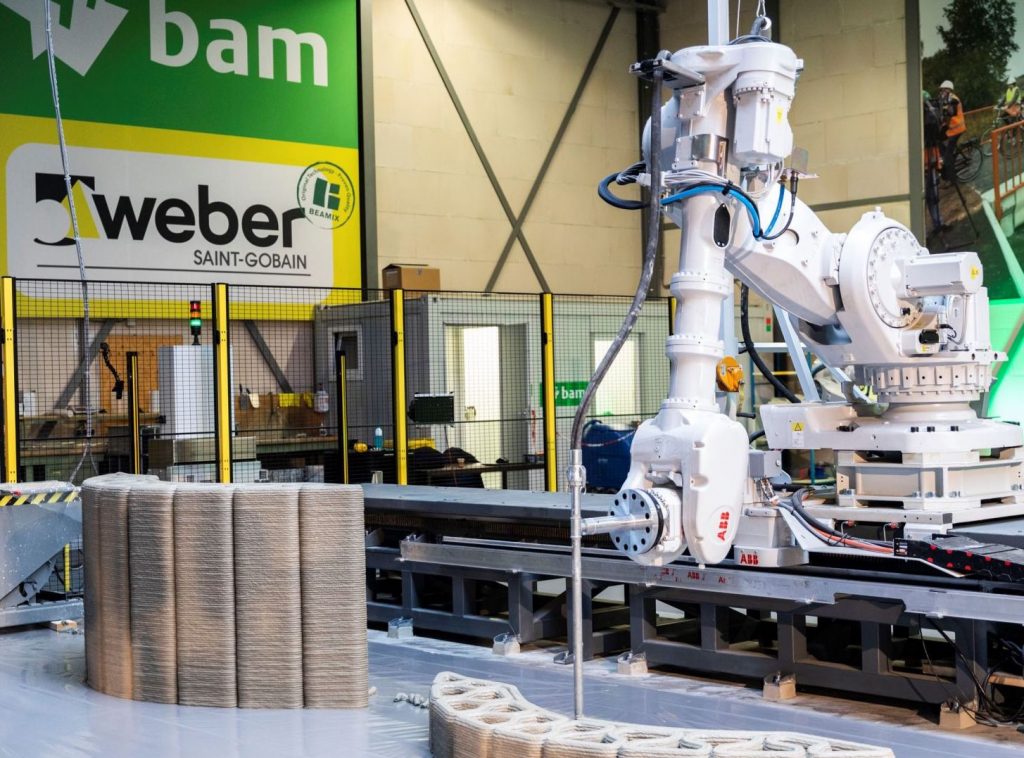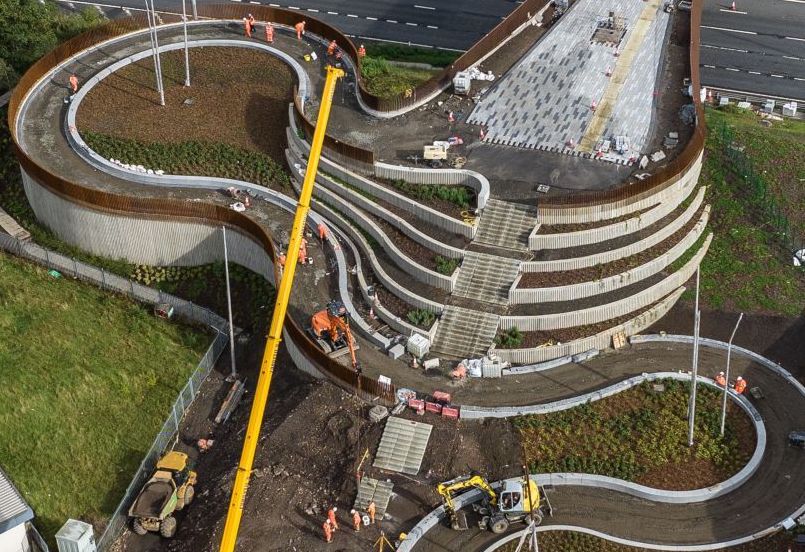Construction firms BAM and Weber Beamix have erected a 3D printed concrete staircase to a footbridge over the M8 motorway in Scotland.
Believed to be the largest structure of its kind in the UK, the staircase leads to a new pedestrian and cycle bridge that when finished, is set to connect Glasgow city center to nearby Sighthill. By 3D printing the build off-site before craning it into place, the firms say they’ve been able to lower its carbon footprint, reduce any risk of disruption, and keep down costs through minimizing the use of molds.
“It’s wonderful to see these 3D concrete printed aspects installed as this iconic bridge takes shape,” said Ian Steele, BAM Contracts Manager for the footbridge. “The printed element saw us manufacture the stairwells off-site, creating strong, one-of-a-kind structures, all while reducing waste and interaction with weather and other elements which can create hold-ups.”
Weber Beamix’s 3D printing factory
Since the turn of the century, Weber Beamix has experimented with 3D printing concrete mortar, and it built its first wall with the technology in 2005. However, it was another decade before it managed to scale the process as part of an initiative with a consortium of companies and the Eindhoven University of Technology.
Building on these advances, Weber Beamix set up a dedicated concrete 3D printing facility with BAM in 2019, which continues to be used as an infrastructure-building base. Two years later, the firms built the world’s-longest 3D printed pedestrian bridge in the Netherlands, which they fabricated at their factory in Eindhoven then shipped to Nijmegen, where it now stands 29.5 meters-long.
Although Weber Beamix bought out BAM’s share in the factory soon afterwards, via a move designed to streamline its operations, BAM indicated its desire at the time to continue working there. This has now played out in the form of a new footbridge contract in Scotland, which BAM has reached out to its long-term partner to fulfill.

A first for Scottish infrastructure
Working on behalf of Glasgow City Council, BAM has become the first contracted to use concrete 3D printing to carry out an infrastructure project in Scotland. As part of the initiative, the firm has partnered with Weber Bemix, 3D printing the stairs at its factory in the Netherlands, then shipping them to Scotland for installation.
In doing so, BAM says it has been able to develop steps with “precise and intricate” shapes that can be difficult to achieve via traditional formwork, while utilizing 3D printing also meant not having to rely on molds and needing 40% less material than conventional methods, thus keeping costs down and improving carbon efficiency.
When it comes to structural integrity, it’s said the staircase is just as strong as if it was constructed on-site, only building it in a controlled environment meant it wasn’t disrupted by weather or on-site risks. As an added benefit, the process enabled the team to integrate automated sensors into materials as well, allowing for the quality of mortar to be monitored throughout the build.
Once complete, the footbridge will connect the center of Glasgow to the Sighthill area in a new sustainable transport corridor, and according to Steele, the technology behind it could now find broader applications in the UK.
“Although this part of the landscaping will ultimately be hidden from site, it marks a huge step forward for BAM in how we modernize our approach to construction,” added Steele. “The use of this technology is in its infancy, but the aspiration is that interest and application grow to such a degree that we can invest in a UK-based printing facility which would improve how we construct within the UK.”

Targeting sustainable bridgebuilding
Concrete 3D printing hasn’t quite disrupted the wider construction sector just yet, but projects like BAM and Weber Beamix’s continue to demonstrate the technology’s potential to do so. Last year, as part of a similar project in Venice, a team at ETH Zurich 3D printed the Striatus bridge, a structure notable for its material efficiency and lack of a need for reinforcement.
Elsewhere in the Netherlands, MX3D has 3D printed a steel bridge in Amsterdam using its proprietary Wire Arc Additive Manufacturing (WAAM) technology. Located in the city’s red light district, the 12.2m-long structure has now been placed over the Oudezijds Achterburgwal canal, ready for use by pedestrians and cyclists.
In China, meanwhile, the world’s first retractable 3D printed bridge has reportedly been built in Shanghai’s Wisdom Bay Innovation Park. Composed of 36 3D printed triangular panels, the 850-kilo structure rolls out to a length of nine meters, and is said to be capable of holding up to twenty people at a time.
To stay up to date with the latest 3D printing news, don’t forget to subscribe to the 3D Printing Industry newsletter or follow us on Twitter or liking our page on Facebook.
While you’re here, why not subscribe to our Youtube channel? featuring discussion, debriefs, video shorts and webinar replays.
Are you looking for a job in the additive manufacturing industry? Visit 3D Printing Jobs for a selection of roles in the industry.
Featured image shows the 3D printed staircase being lowered into place. Photo via BAM.


